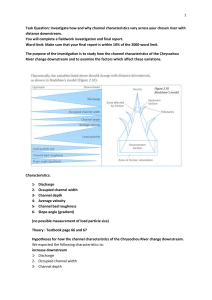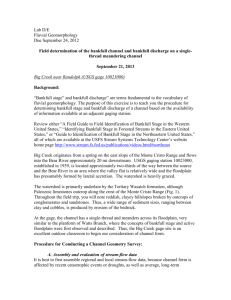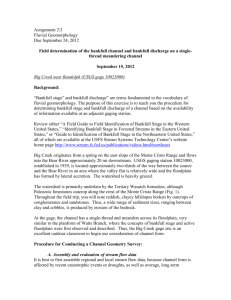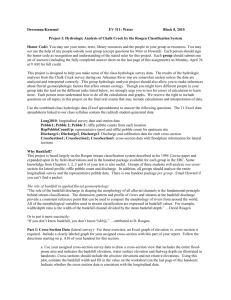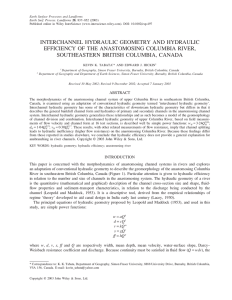Recognition of active floodplains, discriminating floodplains from
advertisement
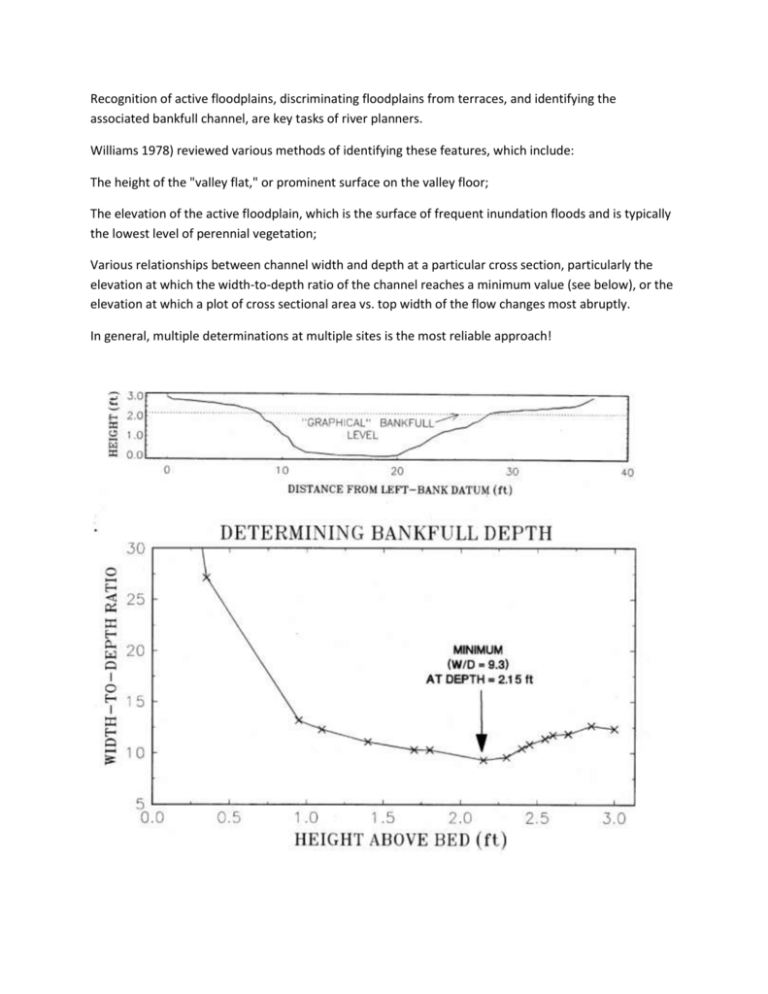
Recognition of active floodplains, discriminating floodplains from terraces, and identifying the associated bankfull channel, are key tasks of river planners. Williams 1978) reviewed various methods of identifying these features, which include: The height of the "valley flat," or prominent surface on the valley floor; The elevation of the active floodplain, which is the surface of frequent inundation floods and is typically the lowest level of perennial vegetation; Various relationships between channel width and depth at a particular cross section, particularly the elevation at which the width-to-depth ratio of the channel reaches a minimum value (see below), or the elevation at which a plot of cross sectional area vs. top width of the flow changes most abruptly. In general, multiple determinations at multiple sites is the most reliable approach! One common method of determining the bankfull depth involves plotting the ratio of the flow width to the depth versus the height above the channel bed (see example above). Near the bed the flow is wide and shallow, so the width-to-depth ratio is high. At flood stages the flow spreads out across the floodplain and the width-to-depth ratio is also high. The bankfull flow depth can be approximated by the flow depth that corresponds with the minimum width-to-depth ratio. THE BANKFULL FLOOD What is the recurrence interval of the bankfull flood? —on non-alluvial channels there is no “bankfull channel”...this is a meaningless question (although it doesn’t stop people from asking it!) —on alluvial channels, most channels fill somewhere between Q1.5 and Q2, i.e. the discharge with a recurrence interval (which = 1/[probability of annual exceedence]) of 1.5 to 2 years. But: this relationship is not universal, or a result of theoretical analyses, or the fourth Law of Thermodynamics. It just seems to work out that way, in most (but by no means all) channels! THE BANKFULL CHANNEL What is “the bankfull channel”? Fundamentally, it is an intuitive concept: you know it when you see it. And yet, there are complications… To be most precise, we need to define the bankfull channel with reference to the adjacent floodplain— i.e. the bankfull channel is the feature that is bounded by the floodplain. What is the floodplain? That surface at the elevation of the top of the bankfull channel. We can resolve this circular definition at either node (channel or floodplain); to start, we will make use an intuitive definition of the bankfull channel and refine it over the next several lectures. So, for now, the bankfull channel is the channel of an alluvial river (recall the first lecture) that has been constructed by, and is in approximate equilibrium with, the river’s current hydrologic and sedimentologic regime. The first lecture (p. 1-13) suggest some ways traditionally used to identify the bankfull channel (or its adjacent floodplain). They are adequate for our purposes, for now. Discharge in a stream system can change in two ways: (1) The changing dimensions of the flow at a single gauging location as discharge changes during the passage of a flood. This type of change is measured by the at-a-station hydraulic geometry. (2) The general increase in discharge as we move downstream and so collect runoff from a progressively greater drainage area. This is measured by the downstream hydraulic geometry. By convention, the hydraulic geometry relationships are written with the following symbols: w =aQb (2) d =cQf (3) u =kQm (4) Multiplying these three equations together, w⋅d⋅u = a⋅c⋅k⋅Q(b+f+m), , (5) And because Q = w⋅d⋅u, Q =a⋅c⋅k⋅Q(b+f+m) (6) and so a⋅c⋅k = 1 (7) b + f + m = 1 (8) Although every stream and stream system has differences, repeated measurements of hydraulic geometry yields remarkably similar values. Values classically reported (data of the 1950’s and 1960’s) for the hydraulic geometry exponents b, f, and m: Hydraulic Geometry of Channels In its most common definition, the hydraulic geometry refers to the way in which the water’s width, depth, and velocity in a channel change with changes in discharge. Although we might acknowledge that other parameters of channel form or of the water flow can also vary (such as slope, roughness, or degree of meandering), these three parameters have the singular property that Q =w⋅d⋅u (1) and so a change in Q must be fully reflected by changes in the width, depth, and velocity. THE HYDRAULIC GEOMETRY OF CHANNELS In its most common definition, the hydraulic geometry refers to the way in which a channel's width, depth, and velocity change with changes in discharge. Although we might acknowledge that other parameters of a channel's form can also vary (such as slope, roughness, or degree of meandering), these three parameters have the singular property that Q = w⋅d⋅u and so a change in Q must be fully reflected by changes in the width, depth, and velocity. Discharge in a stream system can change in two ways (see sketch next page): (1) The general increase in discharge as we move downstream and so collect runoff from a progressively greater drainage area. This is measured by the downstream hydraulic geometry. (2) The changing dimensions of the flow at a single gauging location as discharge changes during the passage of a flood. This type of change is measured by the at-a-station hydraulic geometry. By convention, the hydraulic geometry relationships are written with the following symbols: w = aQb d = cQf u = kQm Multiplying these three equations together, w⋅d⋅u = a⋅c⋅k⋅Q(b+f+m), And because Q = w⋅d⋅u, Q = a⋅c⋅k⋅Q(b+f+m), and so a⋅c⋅k = 1, and b + f + m = 1. Fluid Mechanics Water flowing in a channel is subject to two principal forces: gravity and friction. Gravity drives the flow and friction resists it. The balance between these forces determines the ability of flowing water to transport and erode sediment. In addition, we expect mass and momentum to be conserved at cross sections 1, 2, …, n unless mass or energy are added in between. Conservation of Mass: Q = A1u1= A2u2= ... Anun (1) Conservation of Momentum: ρQ1u1= ρQ2u2= ... ρQnun (2) (note Q = discharge; A = x-sectional area; u = velocity… so these equations are in volume terms) We will use these two basic principles to derive the shear stress that acts on the channel bed (and that transports sediment), the velocity profile in a river, and the equations governing channel flow. General Types of Flow steady: velocity constant with time unsteady: velocity variable with time uniform: velocity constant with position non-uniform: velocity variable with position Simple mathematical models of flow in channels can be constructed only if flow is uniform and steady. Although flow in natural rivers is characteristically non-uniform and unsteady, most models rely upon the steady uniform flow assumption. Reach-Average Shear Stress Natural rivers have local irregularities in bed and bank topography that introduce significant local convergence and divergence of flow that can impose large local gradients in flow velocity and shear stress. We use a reach-average view of channels in order to make for a solvable analytical model. First, consider the force balance on the volume of water in an entire reach of length L and slope θ: Assume that acceleration of flow in the reach is negligible and that the bed is not moving, so there must be a balance between (1) the gravitational force accelerating the water downstream and (2) the frictional resistance to flow caused by the boundary, which slows the fluid velocity to zero at the bed and banks and therefore causes internal deformation of the flow. Within the reach, the downstream component of gravitational force is A L ρg sin θ(3) The total boundary resistance (which is also a force, i.e. = stress · area) for the reach equals τb L P (4) where τb is the average drag force per unit area (shear) on the boundary. Equating the force moving the flow (3) with the force resisting flow (4) (since we are assuming no additional energy inputs), we get τb L P = A L ρg sin θ(5) Rearranging terms and dividing by L yields τb = (A/P) ρg sin θ(6) If we define the hydraulic radius as R ≡(A/P) then this simplifies to the standard expression for the reach-average shear stress τb = R ρg sin θ(7) Note that for wide channels A/P ≈D; and for small θ, sin θ≈tan θ= S. Hence, the reach-average basal shear stress is approximated by the "depth-slope" product: τb = ρg D sin θ(8) **The force exerted by flow on the channel bed is proportional to flow depth and slope**


